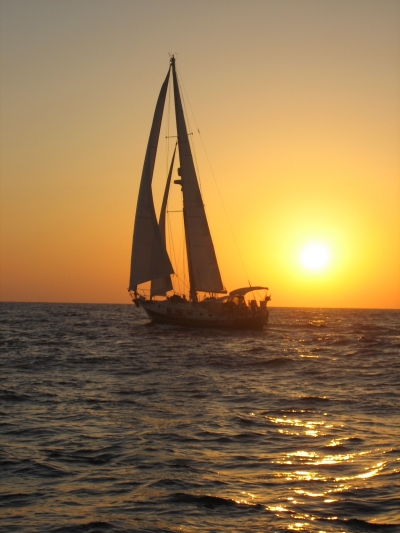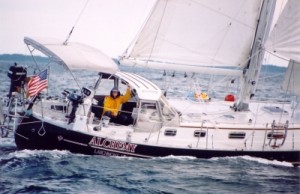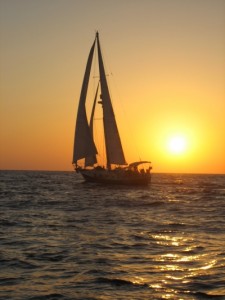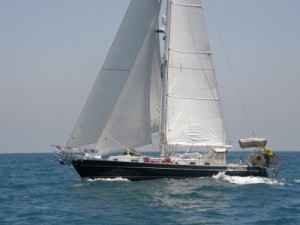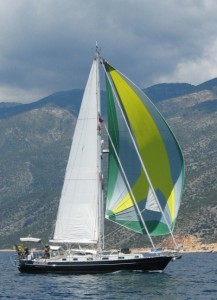Dear SDMC blog subscribers:
What follows is a recent cruising log entry from SDMC Captains’ Club members Dick and Ginger Stevenson, cruising aboard their Valiant 42. Dick and Ginger have been ranging around the Med for several years now and their logs are a delightful mix of cruising wisdom, social commentary and regional history. I look forward to each and every one. They graciously acceded to my request to share this one with my subscribers. Be inspired and enjoy.
Steve D’Antonio
SHIP’S LOG #4, 2010
SHIP’S LOG, ALCHEMY, 30 NOVEMBER 2010
Dear Family and Friends,
We are in Barcelona for the winter and it is proving to be the most immediately engaging city we have ever encountered. In the few weeks we have been here it has been a never ending feast for eyes and palate.
But we had some good cruising getting here from Sardinia. First is the season summary, then a bit about the varied sailing we encountered in this part of the world, ending with the places visited.
Alchemy’s season summary
New countries: Montenegro, Croatia, Bosnia-Herzegovina, Monaco, and France
New anchorages: 68; old: 9; marinas: 13 for 54 days
Mileage: total = 3586, sailing = 1770, motoring = 1816
Longest passage: 7 days, 850 miles, Croatia to Sardinia
Left Kemer, Turkey, 29 March; arrived Barcelona, Spain, 23 October 2010
Most amazing visit: Venice
THE SAILING
We have usually accomplished our mileage in the Med with about 2/3 sailing, 1/3 motoring, but this summer we decided to cover some territory and that caused us to motor more than usual, as reflected in the stats above. The end of the season brought us no lack of wind however. Heading into the central Med also lured us into marinas more than usual, mostly to facilitate visiting interesting land destinations, but also because of difficulty finding safe anchorages at times.
Either September or the change in location (or bad luck) brought us frequent periods of high winds. From our arrival in Sardinia in late August till we arrived in Barcelona in late October we were wind/weather bound no less than 6 times and made decisions based on weather/wind far more than we are accustomed. We were anchored in sustained gale force winds on at least 3 occasions. That said, in between, we had some interesting and magical sailing days.
One memorable sail was actually quite short. We left the protected anchorage of Villefranche, France on the Riviera after sitting out 3-4 days of high winds from the NE. The forecast said the winds had decreased over the night, and from what we could see from deep in the bay things looked fine. In the mile to the mouth of the bay, we were proved impressively wrong. Conditions revealed themselves so quickly that in the time we spent wondering whether to return to the anchorage we also became convinced that the short distance we had already run downwind would make for a hateful, long and difficult backtrack. We kept going in immense seas and gale force wind gusts heading for the mouth of Antibes Marina, only 8 miles away, which promised deep water at the entrance and shelter within. We sailed with just a jib out and were moving at our top speed, our 16 ton boat being tossed around like a cork. Antibes proved to be an easy entrance (a big relief), but what a sleigh ride getting there. Heading toward shore in conditions like that always has you second guessing yourself constantly. It is a bit like shooting down river rapids towards a large and rocky waterfall knowing there is one branch from a sturdy tree sticking out over the river and you have to snag it.
Two other sails stand out, providing contrast for their tranquility. They were both 100 mile or so overnight runs: from Corsica to the south coast of France, and a few weeks later from France across the Gulf de Lion to Spain. Both were door to door medium air comfortable sails in delightful weather—the kind you dream about. Our home, moving quietly at 6 knots or so, no other boats around, doing regular everyday activities like writing emails and making cups of tea, while the boat sails itself along taking us to new destinations.
There were a couple of other spinnaker runs and some lovely day sails, but, generally, this part of the world seems to be more like a giant washing machine that makes the waters forever turbulent. Much of this is due to the aforementioned Gulf de Lion in the south of France, a storm factory constantly generating huge winds and turbulent agitated seas which bounce their way into unexpected corners of the central Mediterranean. In many parts of the Med the wind is primarily from one direction and the weather is not “front” dominated—at least during the sailing season. For example, the Aegean in the summer has the Meltemi which always blows from the north, so anchorages protected only from the north are safe all summer. In this part of the Med, however, the fronts roll through with regularity and, although there may be an expected wind direction for short periods, the winds clock around as these fronts march through. This makes anchoring and anchorages much more of a challenge and there become far fewer anchorages where one can stay for longer periods of time worry free. There are, however, lots of marinas—which have their own disadvantages, including cost.
THE PLACES
I suspect, like most travelers, we never feel as if we have given an area enough time and Sardinia was no exception. We sailed along the east coast from south (Cagliari) to north (The Maddalena Islands and Olbia), with a rental car from each to thread our way inland. Sardinia has some fascinating ancient structures and communities called Nuraghi, dating from around 1800-200 BC, and some of the sites are very well preserved. They are unique in my experience as they are dominated by round buildings and contours which give them an otherworldly feel like Hobbit communities. One wonders what leads to rigidly straight architecture (Greek & Roman), where lines of 20 columns deviate by mere fractions of an inch, and what in a community’s psyche leads to round. (This is especially of interest as we get acquainted with Barcelona’s exceptionally creative architecture, particularly that of Gaudi). It continues to be enchanting to wander around these sites, often with few other visitors, experiencing their inadvertent communication from millennia past.
The north end of Sardinia brought us into one of the Big Money playgrounds of the world and, to our pleasure, a chance to see some of the largest sailing vessels in the world racing against each other. (We try to resist being seduced by what BM is capable of, but this was awesome.) We started this otherworldly experience by being tied to a quay in Olbia next to Mirabella V for almost a week. It is the largest privately owned single-masted sailing vessel in the world and YOU can charter her (with her 16 crew) for a week for a mere ½ million dollars or so. I have seen big boats but this was a quantum leap and I was agog at the size of it every time we passed by. One day we were a bit lost returning to Olbia from a drive in the country until we spotted the tip of Mirabella’s mast in the distance, the tallest thing around. (For those who know boats, Mirabella had a 30+ foot Hinckley Picnic boat stored up its stern.)
We moved a bit north to ritzy Porto Cervo, the harbor where all the Maxi boats, 60-70 of the largest racing and racing/cruising boats in the world, were gathered for a race week. We picked up a temporary mooring that allowed us to see every boat parade a dozen meters in front of us. A few of these boats were not jaw-droppingly interesting or immense or bizarre in some way— but most were. We then went out to watch the race start in 20-30 knots of wind (a lot of wind); it was visually exciting though we stayed pretty far away to ensure we did not get in the way. (We did not want to make the evening news. There were a number of helicopters filming everything.)
Continuing to stay out of the way we headed toward our next anchorage in the Maddalena Islands (remember where Nelson hung out when in the Med?) where we were sure the big boats would not dare to go. We were sailing along tucked in near some shoals and islands watching the big boats truck along when it suddenly became clear that after rounding a mark off in the distance, they were popping their spinnakers (huge sails) in this wind and aiming, at significant speed, straight at us. We managed to stay clear, but were treated to spectacular views of these massive and graceful beasts, spinnakers flying, going as fast as they can go, threading their way through the islands and shoals. I thought the race committee deserved a salute for sending these boats into these waters in that amount of wind; it does not take much bad luck or poor judgment in those conditions to cause millions of dollars in damage. But what fun to watch and how exciting for those on board (largest crew count we observed was 24).
Sardinia, Sicily and Corsica, the 3 large “central” Mediterranean islands, are far from their mother countries in distance and/or feel, and have unique characters and customs, and distinct rough edges. People who live there usually think of themselves as Islanders first and Italian/French second (if at all, as there is frequently some form of separateness movement). Friends, when renting a car in Sardinia, were told, in all sincerity, not to worry about kidnapping and bandits in the inner mountainous parts of Sardinia where they were heading. One Sardinian village we visited, Orgosolo, long a town of bandits, was more recently a hotbed of radical/leftist/communist sentiments which manifest themselves in themed murals on walls and buildings of the town. Wonderful and fascinating displays of “folk/message”” art done in a language I can speak. Not far away is another town, Mamoiada, whose identity was wrapped around the amazing masks and costumes that developed during pagan times in that part of the world. These masks are still an important part of their local winter festival; in summer we were able to see them on display in a museum.
From Sardinia we sailed the short distance north to Corsica, our first stop in France. We motored into the harbor of Bonifacio, a unique cliff top town/fort, and then right out again because of the crowds. We stopped for a few days in the old Roman town, now Porto Vecchio, and then took advantage of a good weather window to sail to Elba, very near the Italian coast. Our route took us past the the dramatically mountainous island of Montecristo—yes, the same island where the Count found his fortune. It would have been a great place to stop except that it’s a national park and closed to the public.
Elba, as you may remember, was the location chosen by the British as the first island of exile for Napoleon. We had a tour of the palace that was his home there; it was clear that he was not in any way deprived in his one year there. Although Elba is very focused on the many tourists who visit or have a second home there, it captivated us with its history and loveliness—fortunately, as we were again trapped by the stormy weather.
From Elba we visited Capraia, a little island N & W of Elba and on the way back to Corsica. We may have had our most relaxed stay of the summer on this Island. It was very protected, and had a small quay where we were stern tied; with our stern to the quay we always feel more part of the community. Best of all was fabulous hiking on passably marked trails that provided challenging trekking, great views and new trails in the three days we stayed. There is also much history on Capraia, which was a penal colony until after WWII. The prisoners worked for centuries to build beautiful stone roads, terraces, churches and quarters, and to farm this mountainous infertile island. Almost all was abandoned when the colony was terminated. According to a local, ex-prisoners and guards live together in town now—no comment about how they get along.
We sailed back to Corsica, stopping in the NE corner before moving on to the NW where we anchored outside Calvi. Although the weather was getting cooler and the fronts a bit more potent, this was a good time for us to be visiting the town. For example, for most of the season Calvi has a huge, well organized, safe and very expensive mooring field taking all the prime real estate for anchoring. We pulled in in early Oct., anchored a stone’s throw from town and made ourselves at home for the next 4-5 days. The mooring field had just been pulled for the winter. Our wish to go up into the mountains by train or car was thwarted by circumstances (we hope to return to remedy this), but we did manage to make one of the best-of-the-summer decision changes. Rather than go west to the Balearic Islands, which we had visited 3 years ago, we went north to the coast of France.
And when I say the coast of France, I mean THE RIVIERA. Monaco, Villefranche, Nice, Antibes, St. Tropez, Toulon and Marseilles all enthralled us, somewhat to our surprise. It may be, and is, the playground of the wealthy, but it is so much more. The Chagall, Matisse (both in Nice), and pointillist (St. Tropez) museums were each wonderful. The Picasso museum (Antibes), located in the castle where he had his studio right after the war, was special (my take) for its ceramics. All the towns were beautiful. Ginger loved the outdoor food markets and the chance to practice her French. We also got lucky with an Australian film festival in St Tropez where–for free AND in English, mind–we saw 4 films over three days, 3 of which were outstanding.
We have heard that cruising the Riviera is very crowded and expensive during the high season, but off season it’s a delight. There were disappointments. Due to the weather we were not able to explore the various islands with their lovely anchorages. And I am still kicking myself for not having bouillabaisse in Marseille because it was so expensive; I don’t like living with regrets.
We had been watching the weather carefully for weeks trying to figure the pattern that would give us the best chance of crossing the Gulf de Lion (100+ miles, an overnight) without getting hammered by its relentless NW winds and truly ugly seas. By the third week in October, which we felt was the latest we wanted to leave for Spain, we were in the marina at Toulon. The previous few days (and off and on for 2 months) we had felt battered by these winds and, feeling very wary, were watching weather reports closely. In the end we had a wonderful sail across as a small front came through, settling the seas with light SE winds, but bringing no real rain or storm with it. We felt blessed.
We had anticipated some stops along the Spanish coast on our way to Barcelona, but unsettled weather was forecast, we were feeling a bit beat up, and the list of boat problems put off to fix in the winter was much longer than usual (generator, refrigeration, battery charger, sail repair, canvas work). So we headed for the barn, looking forward to seeing old friends we knew to be there and some new ones we had met on the way. And, of course, getting acquainted with Barcelona.
We wish all of you great Holidays,
Love, Dick and Ginger, s/v Alchemy, Barcelona, Spain

